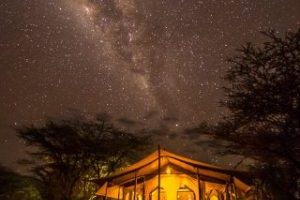Tailor Made
- Your bespoke safari holiday
- Explore Africa at your own pace
- Specialist who listens to your needs
- Tell us what your style is
- Enjoy a personalised experience with Safari Club

 Meru National Park in Kenya
Meru National Park in Kenya
Meru National Park does not appear on many safari itineraries, it is perhaps the least visited of Kenya’s major parks, a pristine and unspoiled environment. Abundantly traversed by streams and with plentiful rainfall, a rolling jungle of tall grass, riverine forest and swamp.
Here in Meru National Park visitors will see a more diverse range of species than in any other park or reserve in Kenya. Regular sightings include Beisa oryx, gerenuk, elephant, Grevy’s zebra, reticulated giraffe, lesser kudu, Grant’s gazelle, leopard, lion, cheetah, rhino and the rare, elusive greater kudu. Meru is famous for its bird life, including riverine and forest species as well as the arid dry country species.
The park is also famous as the place where Elsa the lioness immortalised in the film “Born Free” was released into the wild.
In our opinion Meru National Park is well worth including in any longer Kenyan safari circuit as you will see ...
Meru National Park does not appear on many safari itineraries, it is perhaps the least visited of Kenya’s major parks, a pristine and unspoiled environment. Abundantly traversed by streams and with plentiful rainfall, a rolling jungle of tall grass, riverine forest and swamp.
Here in Meru National Park visitors will see a more diverse range of species than in any other park or reserve in Kenya. Regular sightings include Beisa oryx, gerenuk, elephant, Grevy’s zebra, reticulated giraffe, lesser kudu, Grant’s gazelle, leopard, lion, cheetah, rhino and the rare, elusive greater kudu. Meru is famous for its bird life, including riverine and forest species as well as the arid dry country species.
The park is also famous as the place where Elsa the lioness immortalised in the film “Born Free” was released into the wild.
In our opinion Meru National Park is well worth including in any longer Kenyan safari circuit as you will see some of Kenya’s most stunning wilderness and the likelihood of seeing anyone else while you stay here is small, Meru provides a fascinating contrast to Kenya’s many other national parks.
← Read Less




There is world class accommodation here in all categories, your choice of hotel, lodge or camp will depend on whether you are after a romantic stay or something more family orientated. Our consultants can guide you on the best options for your budget and aspirations.
Below are some successful itineraries that have worked well for our clients. Please call to check availability or better still let us tailor make your own safari holiday.
We usually suggest to include this park in a circuit with other Northern Parks or Maasai Mara to provide a contrast. The viewpoint at Rojewero and Elsa’s grave, along with the Rhino sanctuary are places you might like to visit. Call and speak to one of our specialists for further information.
The cooler dry months between July and October are the optimum time for a visit to Meru, between November and March it can be very warm although the game viewing should still be good. April to June is the rainy season.
January through to March can be the hottest and driest one of the best times to witness some great game viewing. Wildlife is abundant in Kenya all year round and the open terrain of many parks makes for easier game viewing.
The weather in July and August is dry and sunny but the nights can be quite cool. September bring hot days to Meru.
This area is good to visit at any time but prices are much higher in the peak dry season months from July to September.
From Mid March to early June Kenya experiences its long rains driven by the winds of the South East monsoon. The whole country is greener and it is a great time for birders with many species in full breeding plumage. This is the time of year when many species have their young and there are some great deals around.
November sees the start of the short rains which may continue into December, characterized by short sharp showers usually in the mornings or evening followed by clear sunny skies.
January to Mid March are Mid-summer, the short rains should now have ceased with warm days, clear skies. This is usually the hottest and driest time of year and one of the best times to witness some great game viewing, these months fall into the shoulder season pricing bracket so represent good value for money.
 Just a phone call away to start planning your holiday
Just a phone call away to start planning your holiday
01 664 464 228


